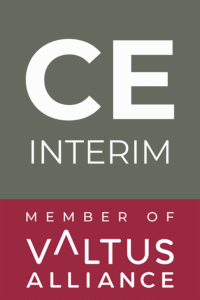¿No tiene tiempo para leer el artículo completo? Escuche el resumen en 2 minutos.
Introducción
La gestión interina es una poderosa herramienta para que las organizaciones aborden necesidades y retos específicos con un liderazgo experimentado de forma temporal. Ya se trate de gestionar una crisis, cubrir un vacío repentino de liderazgo o impulsar iniciativas estratégicas, un gestor interino puede aportar experiencia y soluciones inmediatas. Esta completa guía describe las etapas clave de la gestión interina de proyectos y proporciona información valiosa a las organizaciones que desean aprovechar este enfoque dinámico.
Entender la gestión provisional
¿Qué es la gestión intermedia?
Gestión provisional consiste en colocar temporalmente en una organización a un ejecutivo o alto directivo altamente cualificado para gestionar un proyecto específico o cubrir un vacío de liderazgo. Estos profesionales interinos, a menudo denominados gestores provisionales, poseen una amplia experiencia y pueden adaptarse rápidamente a nuevos entornos, lo que los hace ideales para gestionar asignaciones a corto plazo que requieren atención y experiencia inmediatas.
Ventajas de la gestión interina
La gestión interina ofrece numerosas ventajas, entre ellas
- Experiencia inmediata: Los gestores interinos aportan una gran experiencia y conocimientos especializados para abordar rápidamente retos específicos.
- Flexibilidad: Proporcionan una solución flexible a las organizaciones, permitiéndoles ampliar o reducir los recursos de liderazgo en función de las necesidades.
- Objetividad: Los gestores interinos ofrecen una perspectiva objetiva, libre de políticas internas, que les permite tomar decisiones imparciales.
- Rentable: Contratar a un gestor interino puede ser más rentable que contratar a un ejecutivo permanente, sobre todo para proyectos a corto plazo.
- Gestión del cambio: Son expertos en la gestión del cambio y pueden impulsar transformaciones de forma eficaz dentro de una organización.
Etapas de una gestión provisional de proyectos
1. Preparación y planificación
Comprender la necesidad
La primera etapa de una gestión de proyectos interina consiste en comprender la necesidad específica que requiere un gestor interino. Esto puede deberse a varias razones, como:
- Brecha de liderazgo: Una vacante repentina en un puesto clave de liderazgo que necesita cubrirse inmediatamente.
- Gestión de crisis: Una situación crítica que exige habilidades experimentadas de gestión de crisis.
- Gestión de proyectos: Un proyecto estratégico que requiere conocimientos especializados para su correcta ejecución.
- Transformación empresarial: Cambios organizativos que requieren una gestión del cambio cualificada para garantizar transiciones fluidas.
Comprender las necesidades ayuda a definir el alcance y los objetivos de la gestión provisional de proyectos.
Definición de objetivos
Unos objetivos claros y bien definidos son cruciales para el éxito de la gestión de un proyecto interino. Esto incluye:
- Objetivos del proyecto: Esbozar los objetivos y resultados específicos que se esperan del gestor interino.
- Cronología: Establecer un calendario para el proyecto, con hitos y plazos clave.
- Recursos: Determinar los recursos necesarios, como miembros del equipo, presupuesto y herramientas.
Tener objetivos claros garantiza que todos los implicados estén alineados y centrados en lograr los resultados deseados.
Selección del administrador provisional
Elegir al gestor interino adecuado es fundamental para el éxito del proyecto. El proceso de selección debe incluir:
- Competencias y experiencia: Evaluar a los candidatos en función de sus competencias pertinentes, su experiencia en el sector y sus éxitos anteriores en proyectos interinos similares.
- Ajuste cultural: Garantizar que el gestor interino pueda encajar en la cultura de la organización y trabajar eficazmente con el equipo existente.
- Referencias: Comprobación de referencias y testimonios de clientes anteriores para validar las capacidades y el rendimiento del candidato.
Un proceso de selección minucioso ayuda a encontrar al gestor interino más adecuado que pueda empezar a trabajar de inmediato.
2. Entrada y diagnóstico
Incorporación
Una vez seleccionado el gestor interino, comienza el proceso de incorporación. Una incorporación eficaz implica:
- Orientación: Presentar al gestor interino la cultura, los valores y el personal clave de la organización.
- Documentación: Proporcionar los documentos necesarios, como organigramas, manuales de procesos y resúmenes de proyectos.
- Acceda a: Garantizar que el gestor interino tenga acceso a todos los sistemas, herramientas e información necesarios.
Una incorporación rápida y eficaz ayuda al gestor interino a empezar a contribuir sin retrasos innecesarios.
Análisis de la situación
En la fase de diagnóstico, el gestor interino realiza un análisis exhaustivo de la situación actual. Esto implica:
- Recogida de datos: Recopilación de datos e información pertinentes sobre la organización, los retos específicos y el alcance del proyecto.
- Entrevistas con las partes interesadas: Entrevistas con las principales partes interesadas para conocer sus puntos de vista, expectativas y preocupaciones.
- Análisis DAFO: Realización de un Análisis DAFO (Debilidades, Amenazas, Fortalezas y Oportunidades) para identificar los factores internos y externos que afectan al proyecto.
Un análisis exhaustivo de la situación proporciona al gestor interino una comprensión clara de los retos y las oportunidades, lo que constituye la base de la planificación estratégica.
Participación de las partes interesadas
El compromiso con las partes interesadas es crucial para obtener su apoyo y garantizar la alineación con los objetivos del proyecto. Esto implica:
- Comunicación: Establecer líneas de comunicación claras y abiertas con las partes interesadas, manteniéndolas informadas e implicadas a lo largo de todo el proyecto.
- Creación de relaciones: Generar confianza con las partes interesadas para fomentar la colaboración y la aceptación.
- Gestión de expectativas: Fijar expectativas realistas y gestionar proactivamente las preocupaciones de las partes interesadas.
Una participación eficaz de las partes interesadas garantiza que todos estén de acuerdo y comprometidos con el éxito del proyecto.
3. Desarrollo de la estrategia
Elaborar un plan estratégico
A partir del diagnóstico, el gestor provisional elabora un plan estratégico para abordar los retos identificados y alcanzar los objetivos del proyecto. El plan estratégico debe incluir:
- Medidas: Acciones detalladas necesarias para alcanzar los objetivos del proyecto.
- Asignación de recursos: Asignación de recursos, incluidos los miembros del equipo, el presupuesto y las herramientas.
- Cronología: Un calendario detallado con hitos y plazos concretos.
- Indicadores clave de rendimiento: Indicadores clave de rendimiento (KPI) para medir el progreso y el éxito.
Un plan estratégico bien elaborado sirve de hoja de ruta para el proyecto, guiando al gestor interino y al equipo hacia los resultados deseados.
Evaluación de riesgos
Identificar los riesgos potenciales y desarrollar estrategias de mitigación es una parte vital del proceso de planificación. Esto incluye:
- Identificación de riesgos: Enumerar los riesgos potenciales que podrían afectar al proyecto.
- Análisis de impacto: Evaluar el impacto potencial y la probabilidad de cada riesgo.
- Estrategias de mitigación: Desarrollar estrategias para mitigar o gestionar los riesgos identificados.
Una gestión proactiva de los riesgos garantiza que el proyecto pueda sortear los retos con eficacia y mantener el rumbo.
Establecer hitos
Dividir el proyecto en fases manejables con hitos claros ayuda a seguir el progreso y mantener el impulso. Cada hito debe incluir:
- Resultados específicos: Objetivos y resultados claros para cada fase.
- Plazos: Plazos para completar cada hito.
- Comentarios sobre el progreso: Revisiones periódicas para evaluar los progresos y hacer los ajustes necesarios.
Establecer hitos ayuda a mantener la concentración y a garantizar un progreso constante hacia los objetivos del proyecto.
4. Aplicación
Ejecución del Plan
Una vez establecido el plan estratégico, el gestor interino inicia la fase de ejecución. Esto implica:
- Aplicación de medidas: Ejecución de las acciones previstas, coordinación con el equipo y gestión de los recursos.
- Liderazgo: Proporcionar un liderazgo sólido para guiar al equipo y garantizar la alineación con los objetivos del proyecto.
- Resolución de problemas: Abordar con prontitud y eficacia cualquier problema u obstáculo que surja.
Una ejecución eficaz requiere un liderazgo fuerte, una comunicación clara y una toma de decisiones ágil para impulsar el proyecto.
Control y ajuste
El seguimiento periódico de los avances respecto al plan es crucial. Esto implica
- Seguimiento del progreso: Seguimiento de los indicadores clave de rendimiento y evaluación de los resultados con respecto a los hitos y objetivos.
- Bucles de realimentación: Recoger las opiniones del equipo y de las partes interesadas para identificar cualquier problema o aspecto susceptible de mejora.
- Ajustes: Realizar los ajustes necesarios en la estrategia o el plan de acción en función de la información recibida en tiempo real y de la evolución de las circunstancias.
Este proceso iterativo garantiza que el proyecto siga su curso y pueda adaptarse a nuevos retos u oportunidades.
Informes
Proporcionar actualizaciones periódicas a las principales partes interesadas es esencial para mantener la transparencia y la rendición de cuentas. La información eficaz incluye:
- Informes de situación: Informes periódicos de situación en los que se destaquen los logros, los problemas y los próximos pasos.
- Reuniones con las partes interesadas: Reuniones periódicas con las partes interesadas para debatir los avances, abordar las preocupaciones y garantizar la coherencia.
- Informe final: Un informe final exhaustivo que resume los resultados del proyecto, las lecciones aprendidas y las recomendaciones para el futuro.
Los informes claros y coherentes ayudan a generar confianza y mantienen a todos informados y comprometidos a lo largo del proyecto.
5. Entrega y salida
Transferencia de conocimientos
A medida que el proyecto se acerca a su fin, el gestor interino se centra en transferir conocimientos y responsabilidades al equipo permanente. Esto incluye:
- Documentación: Documentación de procesos, procedimientos y conocimientos clave adquiridos durante el proyecto.
- Formación: Proporcionar formación y apoyo al equipo permanente para garantizar que puedan mantener las mejoras realizadas.
- Reuniones de traspaso: Realización de reuniones de traspaso con el equipo y las partes interesadas para garantizar una transición fluida.
La transferencia eficaz de conocimientos garantiza que la organización pueda seguir beneficiándose de los resultados del proyecto tras la salida del gestor interino.
Evaluación final
Para evaluar el éxito es importante realizar una valoración final de los resultados del proyecto en comparación con los objetivos originales. Esto incluye:
- Evaluación de resultados: Evaluar en qué medida se han alcanzado las metas y objetivos del proyecto.
- Análisis de impacto: Analizar el impacto del proyecto en la organización, incluidas las mejoras o cambios introducidos.
- Lecciones aprendidas: Identificar las lecciones aprendidas y las mejores prácticas que puedan servir de base para futuros proyectos.
Una evaluación final exhaustiva proporciona información valiosa y ayuda a la organización a aprovechar el éxito de la gestión provisional del proyecto.
Estrategia de salida
Una estrategia de salida bien planificada garantiza una transición fluida y minimiza los trastornos. Esto implica:
- Informe de traspaso: Entrega de un informe completo con información detallada sobre el proyecto, resultados y recomendaciones.
- Plan de salida: Elaborar un plan de salida que describa el proceso de salida del gestor interino, incluidas las tareas o responsabilidades finales.
- Seguimiento: Establecer un plan de seguimiento para garantizar que se resuelven las cuestiones pendientes y que la organización sigue beneficiándose del proyecto.
Una estrategia de salida estructurada ayuda a garantizar que la transición sea fluida y que la organización esté bien posicionada para mantener el éxito del proyecto.
Revisión posterior al proyecto
Tras la salida del gestor interino, una revisión posterior al proyecto en la que participen las principales partes interesadas puede aportar información valiosa. Esta revisión ayuda a la organización a reflexionar sobre el impacto del proyecto, evaluar la eficacia de la gestión interina e identificar áreas de mejora para el futuro.
Conclusión
Llevar a cabo con éxito un proyecto de gestión interina implica una preparación minuciosa, una planificación estratégica, una ejecución eficaz y un traspaso sin contratiempos. Siguiendo estas etapas, las organizaciones pueden aprovechar la experiencia de los gestores interinos para afrontar los retos, impulsar la transformación y alcanzar sus objetivos con eficacia.
En CE Interim, ponemos en contacto a gestores interinos experimentados con clientes que buscan un liderazgo temporal en momentos críticos. Tanto si se trata de cubrir carencias como de impulsar iniciativas estratégicas, los proyectos de interinidad ofrecen valiosas experiencias y allanan el camino para futuras oportunidades.





